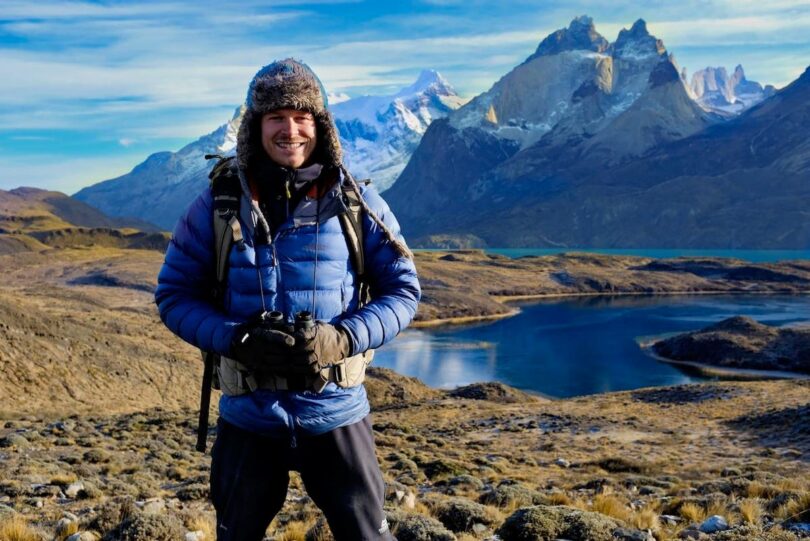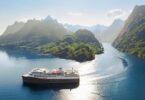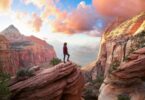A natural high: Bertie Gregory in Patagonia.
Put your feet up, click on National Geographic’s wondrous new Animals Up Close With Bertie Gregory and feel remarkably energized. This six-episode series is a re-imagination of a previous program, Epic Adventures with Bertie Gregory. Premiering September 13th on Disney+, Animals Up Close is an eye-opening, horizon-expanding show — daring and dazzling in its content and cinematography — leading viewers on exceptional journeys to remote destinations. It is steered by 30-year-old visionary filmmaker Bertie Gregory, whose passion, charisma and engaging expertise entice aplenty. He soars and dives, climbs and splashes. An avid globetrotter, born in England, Gregory is a bright star among a fresh, fun, gifted generation of wildlife filmmakers. Gregory and I talked about some of this season’s prime highlights, below.
Chile: Patagonia Pumas
Family affection: In southern Chile, a puma mother and her cubs bask in the sunshine.
South America’s Patagonia draws in nature lovers with its distinctive landscape, which is as hauntingly harsh as it is breathtakingly beautiful. The region’s elusive pumas, also known as mountain lions, are especially dear to Gregory’s heart, as he returns, for this new episode, to the secluded wilderness of southern Chile, where, four years ago, he met a young female puma, who was named Petacca. She rocked his filmmaker spirit. Happy to find her again, Gregory discovers that Petacca is now a mother with two cubs. Photographing her formidable challenges to safeguard and feed her offspring, as well as her efforts to prepare them to become capably independent, is wildlife storytelling at its finest.
Tall order: Bertie Gregory aims for peak heights in Patagonia.
Gregory: “This is my favorite episode because it was nostalgic for me. I first met Petacca four years ago when she was a cub. I had spent a month with her then. She totally relied on her mother at the time and was a bubbling little lovely fluff ball. I stayed in touch with trackers who followed her and we decided that it was a good time to go back to Patagonia. We found that not only had she survived — which is no small feat for pumas, because their chance of survival from cub to adult is not very high — but now she also was this incredible boss mom with cubs of her own. My film crew went on a physical and emotional roller coaster trying to keep up with Petacca as she went about her day to day life, during which she had to fight off male pumas that were trying to kill her cubs. One male was twice as heavy as she was. Petacca was unbelievably brave. The grand finale of the episode is Petacca taking on a guanaco. It’s like a camel with no hump on steroids with a really bad attitude. It is a very dangerous animal for any predator, let alone Petacca, who isn’t that big; she probably weighs 150 pounds or less. This was certainly the most extraordinary battle between predator and prey that I’ve ever witnessed.”
Antarctica: Killer Whales
Predator plans: A killer whale swims near an Antarctic ice floe, spying potential prey.
To reach Antarctica via ship, Gregory and his team cross the Drake Passage, considered the most turbulent expanse of ocean anywhere. They encounter B1 killer whales whose novel strategy to hunt seals resting on ice floes is shocking and ingenious.
Seas the day: Bertie Gregory and his team aboard the ship Australis in Antarctica.
Gregory: “Everyone always wants to know about the cleverness of wild animals. The thing that is special about these killer whales is that they are the best example of animal intelligence. They have learned, as a family group, that they can access seals on ice floes by working together as a team to use their bodies to create a wave, using the water as a whacker to wash the seals off the ice. Absolutely mind-blowing to watch! Every single time we saw them [approach a seal], their tactics were different, the types of waves created were different. It was artful. Not instinctive. It is not a stretch to say that they were using their imagination. The killer whales, when making those waves, can’t see their target, they have to imagine where it is. That, to me, is spine-tingling. These animals are aware of physics. This technique that they have mastered is like that of a professional athlete who masters a sport. We followed the pod that was visibly teaching their calf how to make waves, prioritizing [the lessons] rather than [immediately] getting the food that they were hunting, which shows the importance of this hunting culture, handing it down through generations.”
Botswana: Wild Dogs
Into Africa: A Botswana wild dog stalking prey through muddy grasses.
Gregory traverses Botswana, a landlocked country in southern Africa, defined by the Okavango Delta and the Kalahari Desert. Spotlit is Gregory’s favorite African animal, the wild dog. Although this species is infamous for its superlative hunting acumen, it is endangered, confronting increasing perils from elephants, hyenas and lions. Gregory shadows a family pack with its puppies. What is it like to be a wild dog? What is being done in order to transform their precarious fate?
Plain moves: Cattle and zebra in Botswana.
Gregory: “Wild dogs are the most successful land predator. When they hunt, they have the highest chance of success. At the same time, their populations have nose-dived. In the 1970s and ’80s, there were a half-million wild African dogs; today, there are less than 7,000. Sadly that is largely due to conflict with humans. We were following a wild dog pack of 11 adults and 14 cute pups through its highs and lows. What I love about them is their commitment to family; their pack is tight. Individual dogs will sacrifice their own lives for the sake of the pack, which is lovely to see. One of the best parts of this encounter: We identified each pack member and gave each a name — not because it is a Disney movie, but because it helped us understand the pack dynamics and their relationships with one another, just like humans. All the dogs have different personalities and skills. Some were good hunters, some were good caregivers, so we knew which members to follow.”
Galápagos: Animals Galore
Friendly poses: Bertie Gregory filming beach smiles in the Galápagos.
A volcanic archipelago in the Pacific Ocean, approximately 600 miles off the coast of Ecuador, the ruggedly mesmerizing Galápagos Islands are celebrated for their astounding diversity of animals and plants, many only found here. This is the haven that Charles Darwin visited in 1835, after which he developed his ground-breaking theory of evolution. In this episode, Gregory weaves compelling narratives, along the way facing demanding confrontations, such as massive waves, shark-infested waters and close calls with ultra-swift assertive sea lions.
Undersea magic: Bertie Gregory surrounded by a spectacular shoal of fish in the Galápagos.
Gregory: “For the opening of this episode, we filmed marine iguanas [on Fernandina Island]. They are the only lizards in the world to regularly swim in the sea. They look like mini-Godzillas. They eat seaweed. The best nutritious seaweed grows where they live, an area with very strong currents and waves. These marine iguanas have adapted to be pro-surfers that can duck dive under 10-foot waves. We wanted to show their unique skill — and the only way to do so was to be in the waves with them. I found rather quickly that I got a big slice of humble pie. Those marine iguanas are very at home in the 10-foot waves. We camera people struggled more.”
Central African Republic: Forest Elephants
Gathering place: In Africa’s Dzanga Bai, a family of forest elephants quench their thirst.
Immersed in jungle of the Central African Republic, Gregory stakes out a singular encampment of forest elephants, who live, not on a typical elephant savannah, but segregated within thick, sometimes nearly impenetrable vegetation. His goal was to film secretive tuskers, enormous males with heavy long ivories. Collaborating with local elephant trackers, a specialist camera crew and rope experts, Gregory and his team built a hidden treehouse 120 feet above the jungle floor, as well as a six-by-six-foot square metal filming platform at the edge of a swampy-muddy clearing, called Dzanga Bai, where forest elephants congregate — sort of their covert socializing spot. To transport themselves between the two on-high structures, Gregory’s team strung a 300-foot zip-line. Whee!
Treehouse headquarters: The canopy camp, 120 feet above the jungle ground, where the crew slept.
Gregory: “There is nowhere else on Earth that forest elephants gather in such big numbers as Dzanga Bai, which was a key filming location for us. Because we didn’t want to disturb the elephants, we built the treehouse about 300 feet into the forest. Every day, the zip-line was my commute to work — definitely the most badass commute I’ve ever had! It worked most of the time. Sometimes the weather turned bad. Once we were caught in a storm, lightning everywhere, when one should not be on tall metal objects. We had to zip-line out of that tree in the middle of the night with torrential rain. I was questioning my life choices at that point!”
Indonesia: Devil Rays
Food frenzy: A devil ray amid thousands of anchovy.
Indonesia has stunning coral reefs, where Gregory filmed the mysterious and fugacious devil ray, a gigantic ace predator that is also endangered. He visits Raja Ampat, a group of far-flung isles harboring abundant underwater life, and the Misool Marine Reserve with the Misool Resort, which features a conservation center. His crew also captured memorable moments in the Gorgonian Passage, a narrow waterway running between the islands of Wayilbatan and Walib.
Gearing up: The crew readies for their dive with camera equipment in Indonesia.
Gregory: “This place is a blueprint for how we can protect the environment for the benefit of wildlife and for the benefit of people. The coral reefs that we filmed, 20 years ago they were getting completely trashed by dynamite, fishing and shark-finning [in which a live shark’s fins are cut off, then the shark is tossed back into the water, where it painfully dies]. The local community came together and said enough is enough. They set up this marine reserve, where there is no fishing allowed within the reserve. As a result, the wildlife there has made a comeback and now is home to some of the best if not the best coral reefs in the world. There are now 25 times more sharks in the protected area. It is doing really well. Local fishermen are even benefiting because the overflow of all the bioactivity in the protected area is flowing into the surrounding [legal] fishing areas. Since the natural world is in such dire straits, it is great to know that it is possible to turn it around and this is proof. If you look after nature, it will come back.”
Stay tuned for my follow-up Forbes interview with Bertie Gregory, who reveals behind-the-scenes filming scoops, nature secrets and travel inspirations.








